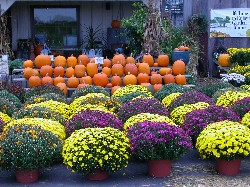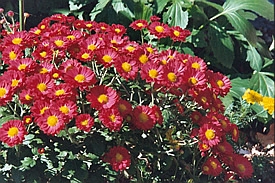Plant of the Week
October 2, 2006
 The garden mum (chrysanthemum) is one of the most excitingflowers that can be grown in the home landscape for late summer and fall color. Garden mums require a minimum amount of care and do well even under some adverse conditions. There are cultivars (varieties) with color that range from white to yellow, pink, purple, bronze, red and all the hues inbetween. With hundreds of cultivars available, the choice of plants to grow is unlimited. To have a more interesting collection of mums, plant cultivars of various types such as: singles, anemones, decoratives, pompons, spoons, spiders, and standards.
The garden mum (chrysanthemum) is one of the most excitingflowers that can be grown in the home landscape for late summer and fall color. Garden mums require a minimum amount of care and do well even under some adverse conditions. There are cultivars (varieties) with color that range from white to yellow, pink, purple, bronze, red and all the hues inbetween. With hundreds of cultivars available, the choice of plants to grow is unlimited. To have a more interesting collection of mums, plant cultivars of various types such as: singles, anemones, decoratives, pompons, spoons, spiders, and standards.
The term, garden mum, applies to chrysanthemum cultivars that will flower naturally in Texas and be early enough to avoid a heavy frost. The term “hardy” has been abandoned by most suppliers since hardiness of garden mum cultivars may vary significantly from one season or area depending on weather and previous cultural conditions.
Garden chrysanthemums are planted in the spring from established cuttings. This is contrary to years ago when they were offered primarily in the fall as clumps. Today the plants are being sold along with annual flowers and vegetables. Most of the plants are sold in pots and must be removed from the pots before planting. The plants generally have had at least one pinch, which results in a well-branched plant.
 The sites for planting should be well-drained and have plenty of sunlight. The plants should be spaced 18 to 24 inches apart for best results, and for more vigorous cultivars, the plants need 30 to 36 inches of space. Enough space should be allowed so the plants can develop to their fullness. Plant the chrysanthemums the same depth that they were growing in their containers and no deeper. The plants should be thoroughly watered after planting.
The sites for planting should be well-drained and have plenty of sunlight. The plants should be spaced 18 to 24 inches apart for best results, and for more vigorous cultivars, the plants need 30 to 36 inches of space. Enough space should be allowed so the plants can develop to their fullness. Plant the chrysanthemums the same depth that they were growing in their containers and no deeper. The plants should be thoroughly watered after planting.
Fertilizing the plants will develop good, green foliage with optimum flowering. Apply a complete dry fertilizer, such as a 6-2-4 or 4-2-3 analysis, at the rate of two to three pounds per 100 square feet of bed area. The dry fertilizer should be watered after it is applied. Soluble fertilizers, such as a 20-20-20 analysis, are also quite satisfactory to use if desired. Follow the rate of application on the label. Fertilization can be discontinued after flower buds form in late July. As the plants grow, they should be pinched to produce compact plants with more flowers. If this isn’t done, the plants will become tall and leggy. Also, if the plants become quite tall, light will be excluded from the lower part of the plants, resulting in unsightly dead leaves.
When the plants are three to four inches tall, remove the new shoots by pinching them off between the thumb and forefinger. Leave two or three leaves on the shoot. This practice can be timed so that the fertilizing and pinching can be done the same day. This will usually be once a month from May through July. However, with most garden cultivars, the last pinch should be made no later than August 15. If pinching is continued after this date, flower buds will be eliminated from the plants.
 Weeds, as with many other plants, may present a problem with growing garden chrysanthemums. These can be removed by hand, or the use of organic mulch could be used at the time of planting. Materials such as shredded hardwood or cedar mulch will do a good job of keeping the weeds down and conserving moisture in the soil if applied about two inches deep. Organic matter such as pine bark (that breaks down rapidly) will require an extra application of fertilizer to compensate for the nitrogen loss. Apply this fertilizer in addition to that which is applied for the plants. However, you will only need to apply it a couple of times and then stop. Pre-emergent herbicides such as Amaze, which are labeled for such use, can also be effective if applied in early spring before weed seeds germinate. Landscape fabrics and decorative gravel are also effective in weed control.
Weeds, as with many other plants, may present a problem with growing garden chrysanthemums. These can be removed by hand, or the use of organic mulch could be used at the time of planting. Materials such as shredded hardwood or cedar mulch will do a good job of keeping the weeds down and conserving moisture in the soil if applied about two inches deep. Organic matter such as pine bark (that breaks down rapidly) will require an extra application of fertilizer to compensate for the nitrogen loss. Apply this fertilizer in addition to that which is applied for the plants. However, you will only need to apply it a couple of times and then stop. Pre-emergent herbicides such as Amaze, which are labeled for such use, can also be effective if applied in early spring before weed seeds germinate. Landscape fabrics and decorative gravel are also effective in weed control.
An important cultural practice with garden chrysanthemums is applying adequate amounts of water. During some summers, rainfall may be plentiful enough to eliminate most additional watering. However, the plants should be watered when the soil starts to dry. Apply enough water to soak the soil to a depth of four to six inches. This is best done by using sprinklers rather than hand watering. It is best to apply the water during the day so the foliage will dry off before nightfall. Otherwise, leaf and flower diseases can become a problem.
Fortunately for garden chrysanthemum growers, most insect and disease problems are controllable. The most common insect pests are: aphids and two spotted mites. Powdery mildew can also be a problem due to weather conditions and/or poor air circulation between the plants. Control by spraying or dusting with labeled products. One disease that cannot be controlled with chemicals is verticillium wilt. Avoid planting in verticillium-contaminated areas for several years.
In most instances, homeowners should consider the the garden chrysanthemum an annual flower. Therefore, when frost kills the tops of the plants, cut off the dead stems and remove from the garden. Sometimes mums will come up the next spring if just the tops of the plants are cut off. If you prefer to keep them over the winter, cut off the dead tops, and cover the plants with mulch to a depth of three to four inches.
For gardeners looking for specific cultivars, the following are widely available in the trade and should do well in San Antonio.
White: Encore, Illusion, Nicole, Tolima
Yellow: Donna, Goldmine, Jessica, Target
Pink: Debonair, Naomi, Stardom, Sundoro
Purple: Barbara Lavender, Ursula Lavender, Venice Purple, Amor Dark Pink, Beth Purple
Bronze: Ginger, Grace, Sandy, Triumph
Red: Bravo, Minngopher, Remarkable
Remember, Learn and Have Fun!
David Rodriguez is the County Extension Agent-Horticulture for Bexar County. He represents Texas Cooperative Extension with the Texas A&M University System. For any landscape or gardening information, call the Bexar County Master Gardeners Hotline at (210) 467-6575, email questions to mg-bexar@tamu.edu, or visit our County Extension website at http://bexar-tx.tamu.edu/
Special Note: Listen to live broadcast of the Home & Garden Show with David Rodriguez & Bill Rohde on WOAI 1200 AM, every Saturday morning between 8:00-11:00 a.m., and call in your gardening questions at (210) 737-1200 or 1-800-383-9624. Check it out!